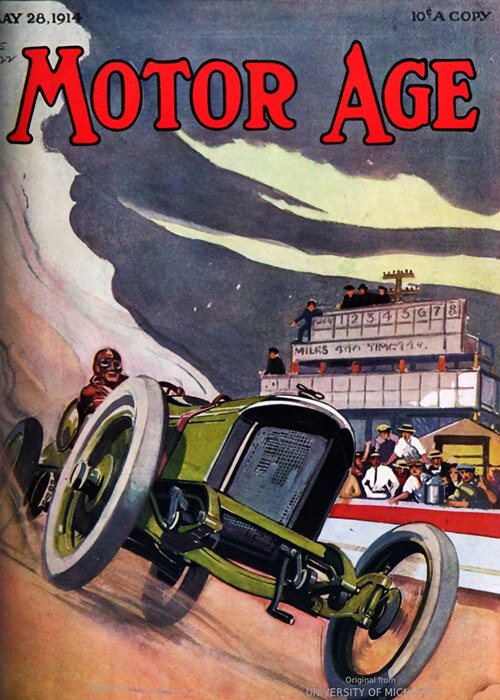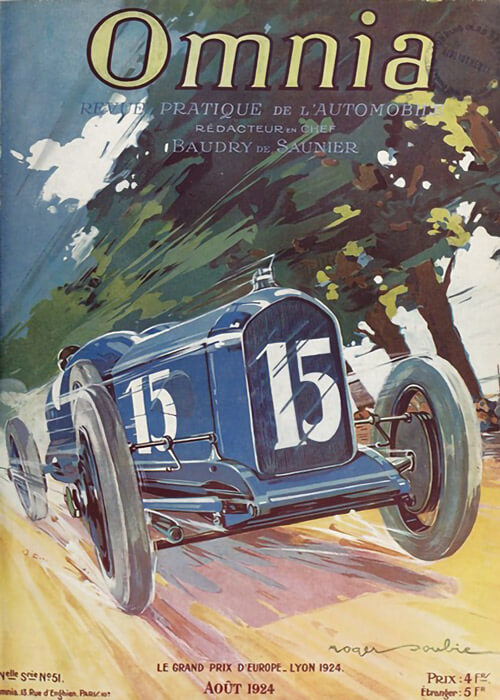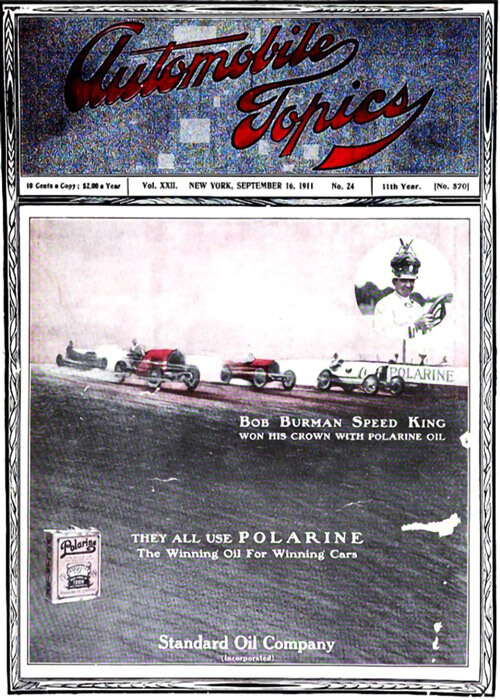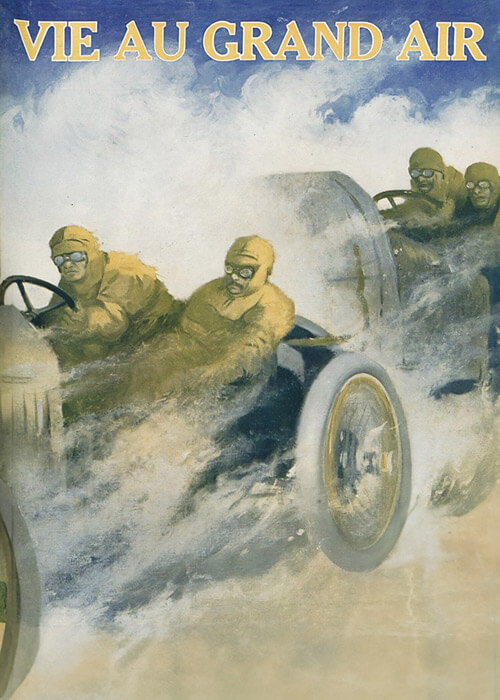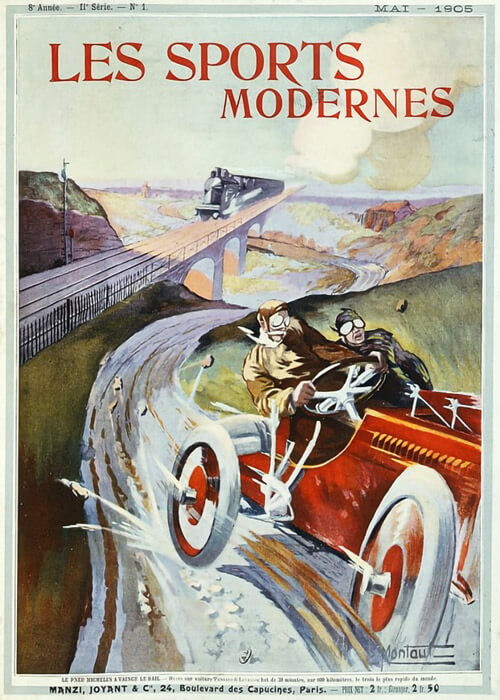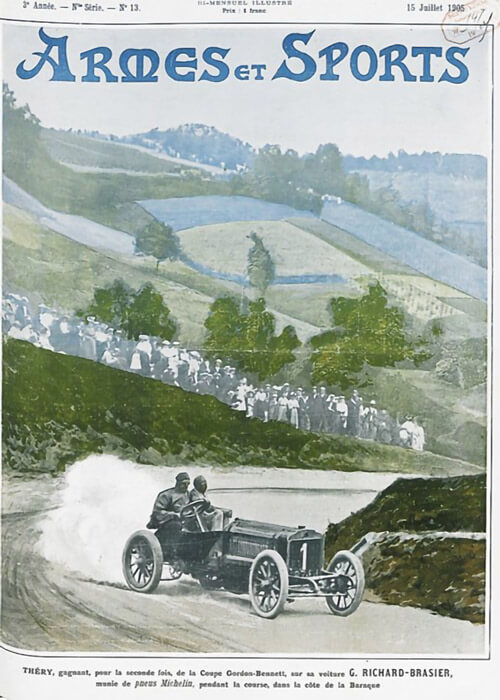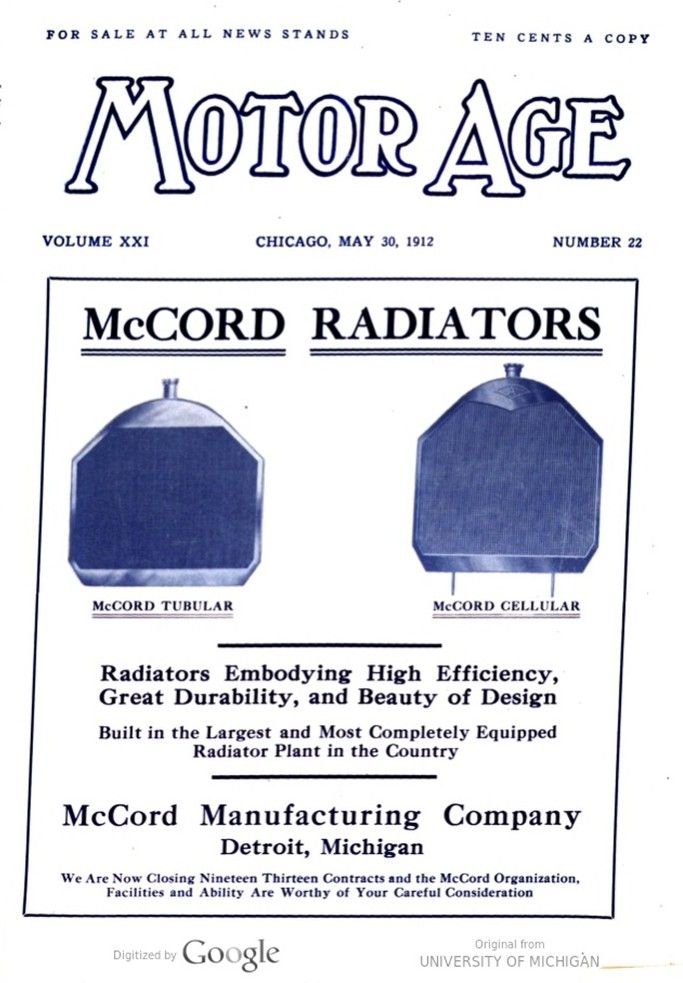
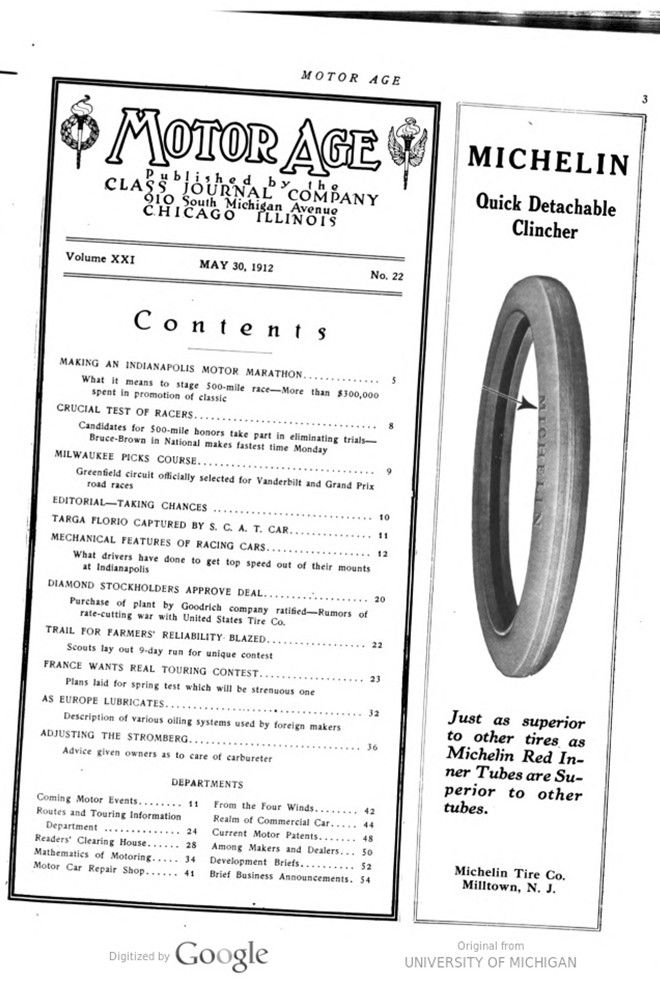
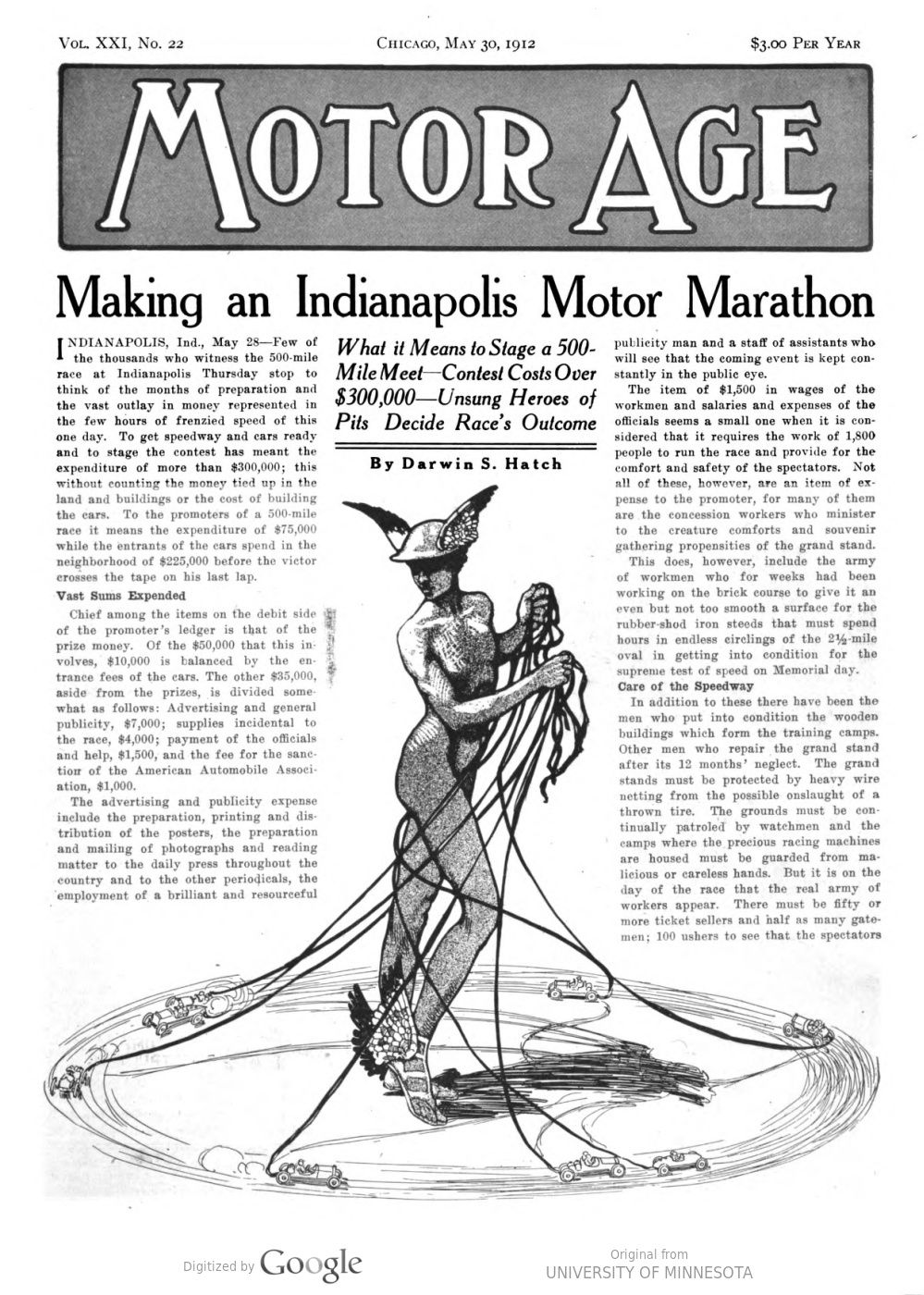
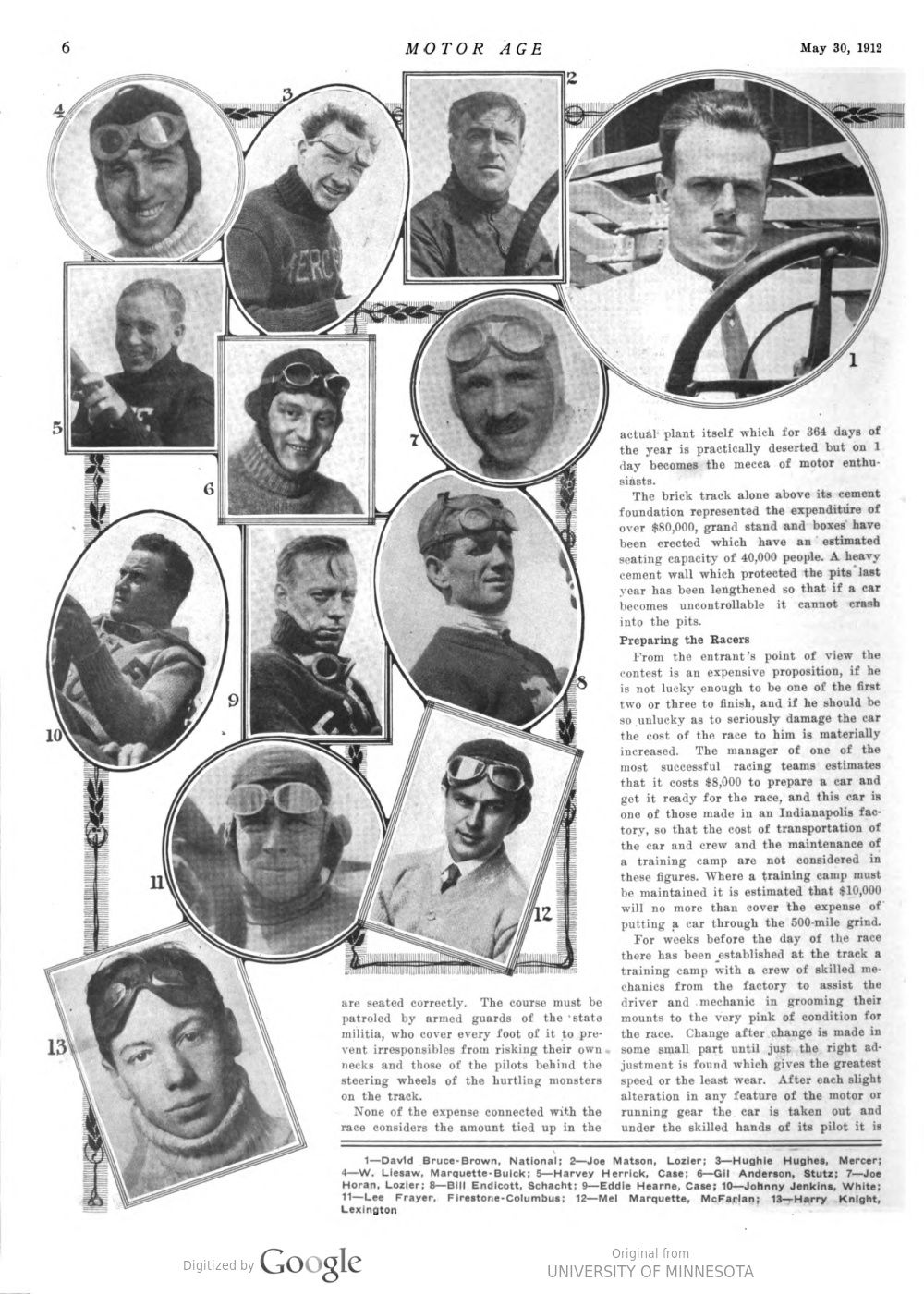
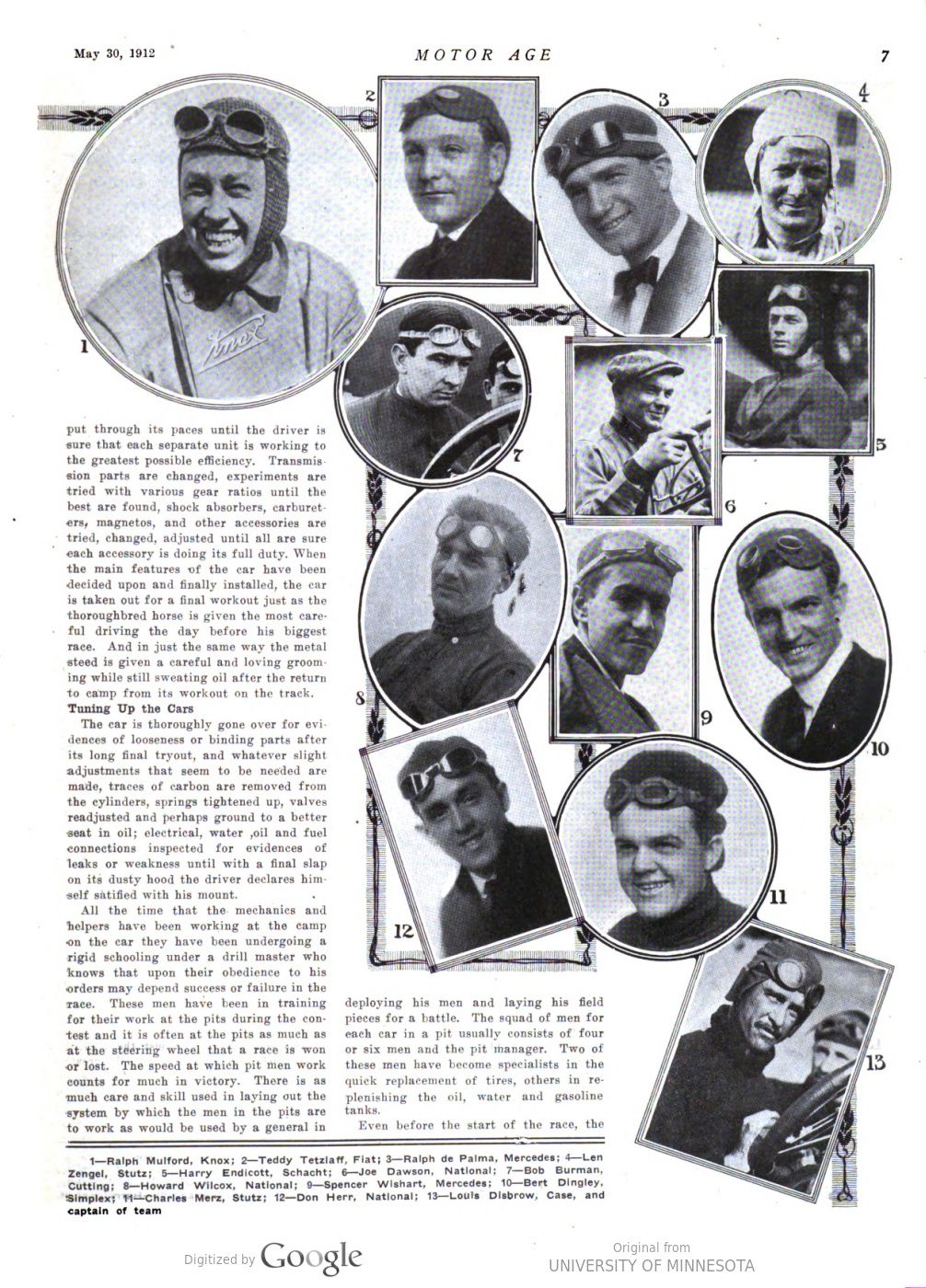
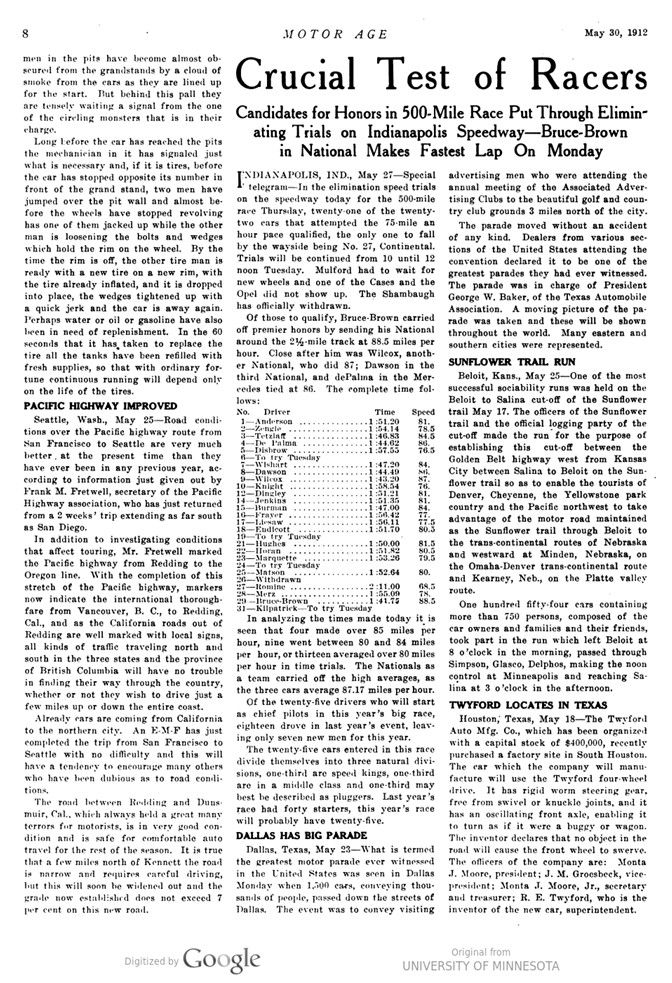
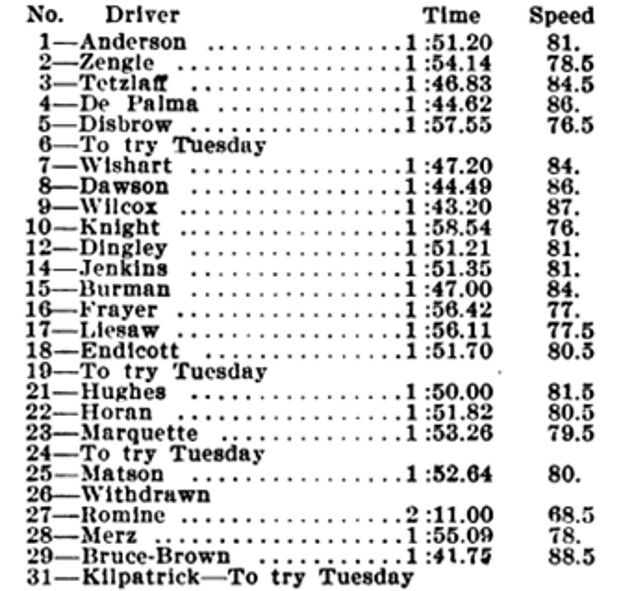
Text and jpegs by courtesy of hathitrust.org www.hathitrust.org, compiled by motorracinghistory.com
MOTOR AGE Vol. XXI, No. 23 Chicago, May 30, 1912
Making an Indianapolis Motor Marathon
What it Means to Stage a 500-Mile Meet – Contest Costs Over $300,000 – Unsung Heroes of Pits Decide Race’s Outcome
INDIANAPOLIS, Ind., May 28 – Few of the thousands who witness the 500-mile race at Indianapolis Thursday stop to think of the months of preparation and the vast outlay in money represented in the few hours of frenzied speed of this one day. To get speedway and cars ready and to stage the contest has meant the expenditure of more than $300,000; this without counting the money tied up in the land and buildings or the cost of building the cars. To the promoters of a 500-mile race it means the expenditure of $75,000 while the entrants of the cars spend in the neighborhood of $225,000 before the victor crosses the tape on his last lap.
Vast Sums Expended
Chief among the items on the debit side of the promoter’s ledger is that of the prize money. Of the $50,000 that this involves, $10,000 is balanced by the entrance fees of the cars. The other $35,000, aside from the prizes, is divided somewhat as follows: Advertising and general publicity, $7,000; supplies incidental to the race, $4,000; payment of the officials and help, $1,500, and the fee for the sanction of the American Automobile Association, $1,000.
The advertising and publicity expense include the preparation, printing and distribution of the posters, the preparation and mailing of photographs and reading. matter to the daily press throughout the country and to the other periodicals, the employment of a brilliant and resourceful publicity man and a staff of assistants who will see that the coming event is kept constantly in the public eye.
The item of $1,500 in wages of the workmen and salaries and expenses of the officials seems a small one when it is considered that it requires the work of 1,800 people to run the race and provide for the comfort and safety of the spectators. Not all of these, however, are an item of expense to the promoter, for many of them are the concession workers who minister to the creature comforts and souvenir gathering propensities of the grand stand.
This does, however, include the army of workmen who for weeks had been working on the brick course to give it an even but not too smooth a surface for the rubber-shod iron steeds that must spend hours in endless circlings of the 2½-mile oval in getting into condition for the supreme test of speed on Memorial day.
Care of the Speedway
In addition to these there have been the men who put into condition the wooden buildings which form the training camps. Other men who repair the grand stand after its 12 months‘ neglect. The grand stands must be protected by heavy wire netting from the possible onslaught of a thrown tire. The grounds must be continually patrolled by watchmen and the camps where the precious racing machines are housed must be guarded from malicious or careless hands. But it is on the day of the race that the real army of workers appear. There must be fifty or more ticket sellers and half as many gatemen; 100 ushers to see that the spectators are seated correctly. The course must be patrolled by armed guards of the state militia, who cover every foot of it to prevent irresponsibles from risking their own necks and those of the pilots behind the steering wheels of the hurtling monsters on the track.
None of the expense connected with the race considers the amount tied up in the actual plant itself which for 364 days of the year is practically deserted but on 1. day becomes the mecca of motor enthusiasts.
The brick track alone above its cement foundation represented the expenditure of over $80,000, grand stand and boxes‘ have been erected which have an estimated seating capacity of 40,000 people. A heavy cement wall which protected the pits last year has been lengthened so that if a car becomes uncontrollable it cannot crash into the pits.
Preparing the Racers
From the entrant’s point of view the contest is an expensive proposition, if he is not lucky enough to be one of the first two or three to finish, and if he should be so unlucky as to seriously damage the car the cost of the race to him is materially increased. The manager of one of the most successful racing teams estimates that it costs $8,000 to prepare a car and get it ready for the race, and this car is one of those made in an Indianapolis factory, so that the cost of transportation of the car and crew and the maintenance of a training camp are not considered in these figures. Where a training camp must be maintained it is estimated that $10,000 will no more than cover the expense of putting a car through the 500-mile grind. For weeks before the day of the race there has been established at the track a training camp with a crew of skilled mechanics from the factory to assist the driver and mechanic in grooming their mounts to the very pink of condition for the race. Change after change is made in some small part until just the right adjustment is found which gives the greatest speed or the least wear. After each slight alteration in any feature of the motor or running gear the car is taken out and under the skilled hands of its pilot it is put through its paces until the driver is sure that each separate unit is working to the greatest possible efficiency. Transmission parts are changed, experiments are tried with various gear ratios until the best are found, shock absorbers, carbureters, magnetos, and other accessories are tried, changed, adjusted until all are sure each accessory is doing its full duty. When the main features of the car have been decided upon and finally installed, the car is taken out for a final workout just as the thoroughbred horse is given the most careful driving the day before his biggest race. And in just the same way the metal steed is given a careful and loving grooming while still sweating oil after the return to camp from its workout on the track.
Tuning Up the Cars
The car is thoroughly gone over for evidences of looseness or binding parts after its long final tryout, and whatever slight adjustments that seem to be needed are made, traces of carbon are removed from the cylinders, springs tightened up, valves readjusted and perhaps ground to a better seat in oil; electrical, water, oil and fuel connections inspected for evidences of leaks or weakness until with a final slap on its dusty hood the driver declares himself satisfied with his mount.
All the time that the mechanics and helpers have been working at the camp on the car they have been undergoing a rigid schooling under a drill master who knows that upon their obedience to his orders may depend success or failure in the race. These men have been in training for their work at the pits during the contest and it is often at the pits as much as at the steering wheel that a race is won or lost. The speed at which pit men work counts for much in victory. There is as much care and skill used in laying out the system by which the men in the pits are to work as would be used by a general in deploying his men and laying his field pieces for a battle. The squad of men for each car in a pit usually consists of four or six men and the pit manager. Two of these men have become specialists in the quick replacement of tires, others in replenishing the oil, water and gasoline tanks. Even before the start of the race, the men in the pits have become almost obscured from the grandstands by a cloud of smoke from the cars as they are lined up for the start. But behind this pall they are tensely waiting a signal from the one of the circling monsters that is in their charge.
Long before the car has reached the pits the mechanician in it has signaled just what is necessary and, if it is tires, before the car has stopped opposite its number in front of the grand stand, two men have jumped over the pit wall and almost before the wheels have stopped revolving has one of them jacked up while the other man is loosening the bolts and wedges which hold the rim on the wheel. By the time the rim is off, the other tire man is ready with a new tire on a new rim, with the tire already inflated, and it is dropped into place, the wedges tightened up with a quick jerk and the car is away again. Perhaps water or oil or gasoline have also been in need of replenishment. In the 60 seconds that it has taken to replace the tire all the tanks have been refilled with fresh supplies, so that with ordinary fortune continuous running will depend only on the life of the tires.
Photo captions.
Page 6.
1-David Bruce-Brown, National; 2-Joe Matson, Lozier; 3-Hughie Hughes, Mercer; 4-W. Liesaw, Marquette-Buick; 5-Harvey Herrick, Case; 6-Gil Anderson, Stutz; 7-Joe Horan, Lozier; 8-Bill Endicott, Schacht; 9-Eddie Hearne, Case; 10-Johnny Jenkins, White; 11-Lee Frayer, Firestone-Columbus; 12-Mel Marquette, McFarlan; 13-Harry Knight, Lexington.
Page 7.
1-Ralph Mulford, Knox; 2-Teddy Tetzlaff, Fiat; 3-Ralph de Palma, Mercedes; 4-Len Zengel, Stutz; 5-Harry Endicott, Schacht; 6-Joe Dawson, National; 7-Bob Burman, Cutting; 8-Howard Wilcox, National; 9-Spencer Wishart, Mercedes; 10-Bert Dingley, Simplex; 11-Charles Merz, Stutz; 12-Don Herr, National; 13-Louis Disbrow, Case, and captain of team
Crucial Test of Racers
Candidates for Honors in 500-Mile Race Put Through Eliminating Trials on Indianapolis Speedway – Bruce-Brown in National Makes Fastest Lap On Monday
INDIANAPOLIS, IND., May 27 – Special telegram – In the elimination speed trials on the speedway today for the 500-mile race Thursday, twenty-one of the twenty- two cars that attempted the 75-mile an hour pace qualified, the only one to fall by the wayside being No. 27, Continental. Trials will be continued from 10 until 12 noon Tuesday. Mulford had to wait for new wheels and one of the Cases and the Opel did not show up. The Shambaugh has officially withdrawn. Of those to qualify, Bruce-Brown carried off premier honors by sending his National around the 22-mile track at 88.5 miles per hour. Close after him was Wilcox, another National, who did 87; Dawson in the third National, and de Palma in the Mer- cedes tied at 86. The complete time follows: (see table).
In analyzing the times made today it is seen that four made over 85 miles per hour, nine went between 80 and 84 miles per hour, or thirteen averaged over 80 miles per hour in time trials. The Nationals as a team carried off the high averages, as the three cars average 87.17 miles per hour.
Of the twenty-five drivers who will start as chief pilots in this year’s big race, eighteen drove in last year’s event, leaving only seven new men for this year.
The twenty-five cars entered in this race divide themselves into three natural divisions, one-third are speed kings, one-third are in a middle class and one-third may best be described as pluggers. Last year’s race had forty starters, this year’s race will probably have twenty-five.
